Christen Eagle II
Crash page!
All of these photos are the result of a head-on mid-air collision back in 1991 between my Byron Christen Eagle II and a Goldberg Eagle 63 trainer. The head-on collision occurred at about 300 feet above the ground. Then it rained balsa, foam, plywood, Monokote, Econokote, radio parts, and engine parts for what seemed like 5 minutes. Except for one photo, this is the exact condition that the Christen Eagle was in as it "glided" back to earth, with the engine still idling, and then successfully "landed", with no further damage.
After passing directly through the spinning 20 inch propeller,
the entire Goldberg Eagle 63 was totally destroyed.....including the engine,
the radio, and the airplane itself. In a flash, the Goldberg Eagle
63 transformed from an airplane, to a cloud of falling debris. Some
parts of it's engine, radio, and airframe were never found.
The pilot of the Goldberg Eagle was left with only a
transmitter........nothing else.
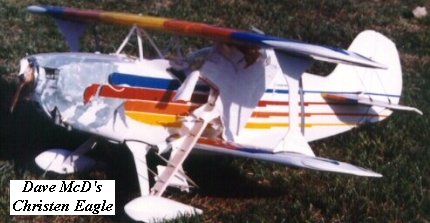
The Goldberg Eagle 63 struck the spinner, then went directly
through the spinning propeller of the Christen Eagle, where it was completely
disintegrated. Wedged between the wings and landing gear is the biggest
remaining piece of the Goldberg Eagle 63, a portion of the wing center
section and a piece of the spar.
EVERYTHING on the Eagle 63 was virtually destroyed!
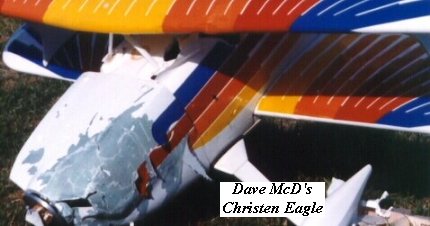
(Eagle 63 wing spar removed for this photo)
The spinner, prop, cowl, and the cabane section were
severely damaged. The impact even bent the crankshaft of the Sachs
2.6. Note the missing areas of the fuselage top section. When
the top of the fuselage was shattered by the impact, the cabane assembly
was ripped free of the fuselage. Only the "I" struts were left holding
the top wing in place as it glided to the ground.
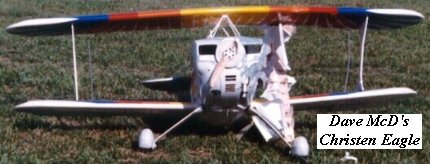
The remains of the Eagle 63 wing got trapped between the top wing and the left landing gear. The impact also broke one of the top wing spars. You can see the damaged spinner, cowl, and prop where they collided head-on. Note the bent landing gear, the bent aileron pushrod, and how the top wing is bowed.

The impact shattered the top of the fuselage and ripped the cabane mounting assembly completely out of the fuselage. But pay particular attention to the broken stripes under the canopy. The impact broke the fuselage completely in half at this point, and also on the opposite side. The only thing holding the tail section in place were the pull-pull cables from the rudder and elevators!
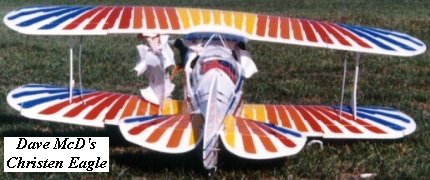
Here the damage to the fuselage is a little more obvious. Notice the oddly skewed angle of the tail section. The front section of the fuselage ended up taking the brunt of the collision. The foam around the firewall was severely smashed and compressed, but the fiberglass cloth reinforcement on the outside edge of the firewall kept it from coming off completely. I was EXTREMELY lucky that the fuel tank didn't rupture, and spill gasoline all over inside of the foam airplane!
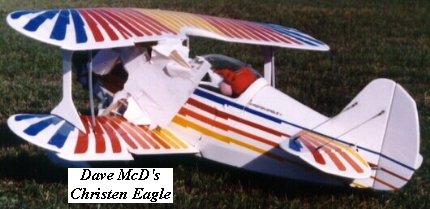
Here's the other crack in the fuselage (from trailing edge up to pilot) where the left side of the fuselage was completely broken in half. Good thing I'd decided to replace the elevator and rudder pushrods with pull-pull cables, or the rear half of the fuselage would have come off in-flight, and ended up totally destroying the Christen Eagle. Do I feel lucky??? You bet!!!
After this crash, the Christen Eagle II was repaired, and the repairs are almost unnoticeable. The cowl, spinner, and prop were replaced. The engine crankshaft and the landing gear were straightened. The fuselage was pieced back together with Hot Stuff UFO and/or epoxy, and then the repaired areas were fiberglassed on the inside using epoxy and/or UFO. The repaired fuselage was completely recovered with Econokote all the way back to the leading edge of the horizontal stabilizer. The wings were repaired by splicing the spars back together, gluing blocks of white foam to the damaged areas, and then sanding them to shape before covering the areas with Econokote. New decals were purchased and applied to the fuselage and the damaged areas of the wings. Although it cost me several hundred dollars to repair it, I'm glad I did, and it's still in flyable condition today!
Comments?
E-Mail me at:
dmcdnld@yhti.net